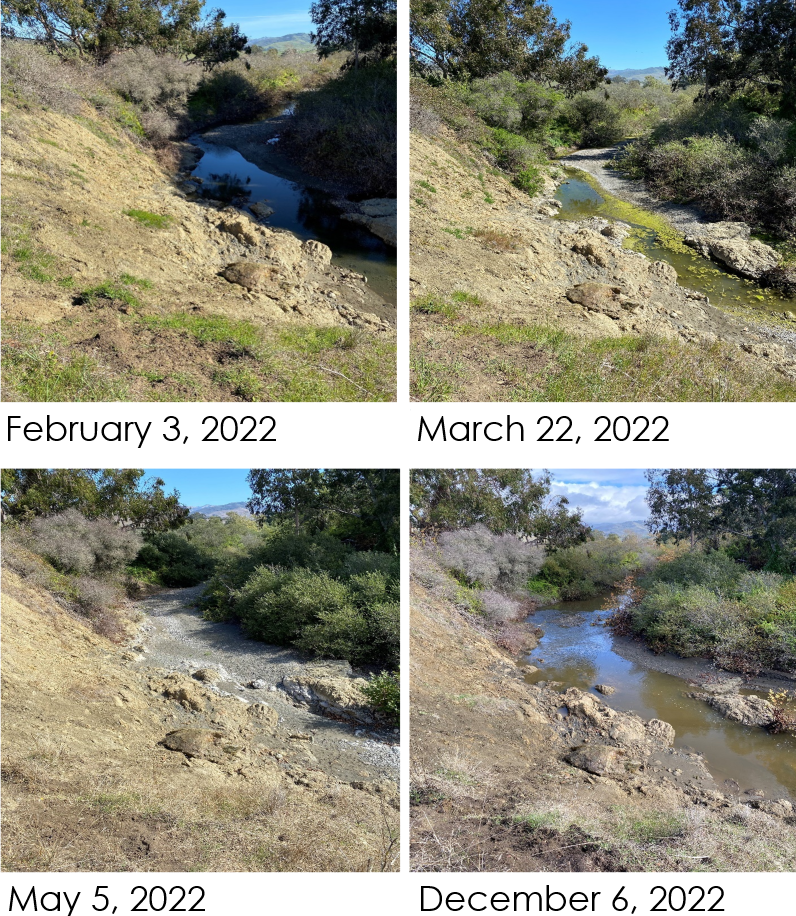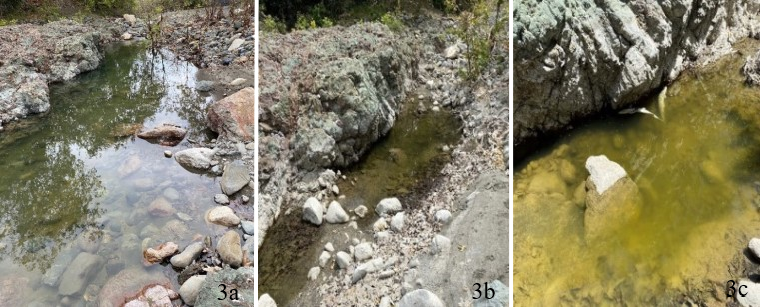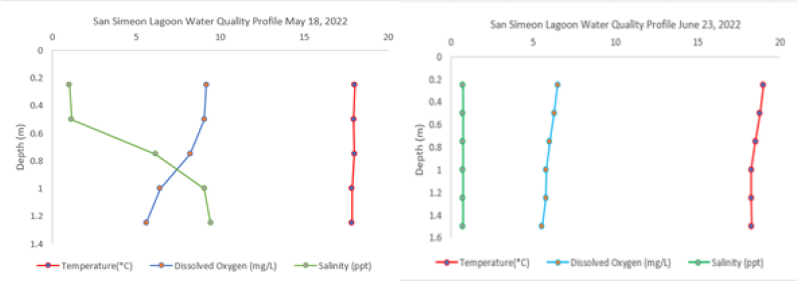Species and Location
The San Luis Obispo Coastal Terrace is home to a handful of coastal creeks that support a Distinct Population Segment of South-Central California Coast steelhead (Oncorhynchus mykiss), which are federally threatened and protected under the Endangered Species Act (Boughton, 2022). One such creek of interest is San Simeon Creek in San Luis Obispo County, California (Figure 1). This creek originates in the Santa Lucia Mountain range at roughly 3,400ft and transitions into a low gradient coastal creek. The watershed encompasses a 35 square mile area and has two major tributaries, Van Gordon Creek and Steiner Creek. This watershed is designated as having a Core 1 population of South-Central California Coast steelhead (SCCC steelhead), which is the highest priority for recovery according to the NOAA-NMFS recovery plan (NMFS, 2013 South-Central California Steelhead recovery plan). This creek traditionally supports both anadromous and residential populations of O. mykiss but there is little information available on population abundance. Historically this creek has been prone to extensive dry backs during drought conditions, so CDFW R4-Coastal Aquatic Stressor Monitoring staff chose San Simeon Creek to conduct extensive drought monitoring beginning in February 2022 with the intent to answer the question of how the current drought is effected this watershed and how the O. mykiss population was reacting to these extreme conditions.
 Figure 1.San Simeon Creek Watershed and Drought Monitoring sites.
Figure 1.San Simeon Creek Watershed and Drought Monitoring sites.
Need for Drought Stressor Monitoring
Drought aquatic stressor monitoring staff began water quality monitoring on San Simeon Creek in February 2022. Unfortunately, the peak base flow events associated with large rain systems during the winter and early spring months never materialized and water quality conditions only degraded as the season progressed. Spring recession flow conditions began occurring in February, while historically recession flow regimes should start in late May. One of the most significant impacts from a lack of significant rain events was that the San Simeon Creek lagoon never opened or had hydrological connectivity to the open ocean from February until December 2022. This trapped all the steelhead that had entered the system earlier in the season and kept them from migrating back out into the open ocean after spawning up higher in the watershed. To further compound this below average water year, dry backs and fragmentation began to show in early March. This fragmentation of the creek isolated numerous adult steelhead throughout the mainstem of San Simeon Creek during the peak of the spawning season (January through April). The question about conducting fish rescues was brought to our team’s attention from both the public and staff. The main question staff set out to answer is, where would suitable habitat exist to translocate these isolated fish and can this translocation site sustain fish over summer while enduring extreme drought conditions. With no historical data to support areas where perennial creek conditions exist to relocate these isolated fish, staff assessed lagoon conditions to determine if water quality could sustain translocated fish throughout the dry season. The main water quality metrics that staff were interested in were determining if a halocline and/or thermocline were present and at what depth they were present in the lagoon. Haloclines and thermoclines represent a vertical layer in the lagoon water column of increased salinity and increased water temperature. These layers have the effect of decreasing the availability of suitable habitat for O. mykiss.
Methods and Stressor Monitoring Efforts
To monitor this watershed, staff conducted weekly site visits looking at water quality metrics such as water temperature and dissolved oxygen at the lower, middle, and upper reach sample sites. Staff conducted monthly wet dry surveys where they would walk the entire mainstem of San Simeon Creek to identify where the creek had flowing water and where the creek had gone dry. These monthly wet dry surveys also allowed staff to identify isolated pools and fragmented habitat that housed trapped adult and juvenile O. mykiss. To identify if the lagoon would be a suitable translocation site for rescued fish, staff began monitoring water quality in the lagoon by conducting monthly water quality profiles at a site located in the deepest section mid lagoon. These profiles looked at water temperature, salinity, and dissolved oxygen at increasing depths of 0.25 meters until the bottom was reached. Monitoring of these metrics began in February of 2022 and continued through December 2022.
Findings
While conducting monthly wet dry surveys, staff found multiple isolated pools where adult steelhead were trapped. Staff monitored water temperature, dissolved oxygen, and overall condition of fish at these sites regularly until the fish died (Figure 2 & 3).
 Figure 2. Time lapse of lower San Simeon Creek, San Luis Obispo County, CA.
Figure 2. Time lapse of lower San Simeon Creek, San Luis Obispo County, CA.
 Figure 3. Time lapse of deep pool near middle reach of San Simeon Creek San Luis Obispo County, CA.
Figure 3. Time lapse of deep pool near middle reach of San Simeon Creek San Luis Obispo County, CA.
 Figure 4. Adult steelhead carcass from deep pool near middle reach on San Simeon Creek May 16, 2022.
Figure 4. Adult steelhead carcass from deep pool near middle reach on San Simeon Creek May 16, 2022.
Staff identified a total of ten adult steelhead carcasses that died from the extreme drought conditions on San Simeon Creek (Figure. 4). Staff observed tens of thousands of juvenile O. mykiss that perished as rapid and extreme drought dried a majority of the main stem and all the deep pools that would, in normal water years, act as over summer refugia habitat. The February wet dry survey showed that the creek was fully connected but the lagoon was closed to the open ocean. The May wet dry survey showed that 33% of the main stem had already gone completely dry, which is a crucial timeframe for rearing of juvenile O. mykiss. The September survey showed and astonishing 72% of the main stem was completely dry, 15% was intermediate (wetted with minimal hydrological connectivity), and only 13% was still wetted. Due to early winter storms, the San Simeon Creek regained full connection and was open to the ocean on the December 2022 wet dry survey (Figure 5).
 Figure 5. Wet Dry Surveys showing progression of Fragmentation and drying. May wet/dry survey show locations and date where adult steelhead carcass were found.
Figure 5. Wet Dry Surveys showing progression of Fragmentation and drying. May wet/dry survey show locations and date where adult steelhead carcass were found.
The lagoon water quality profiles show a minor halocline present at a depth of 0.75m as the salinity jumped from 1.0ppt to 9.0ppt on the May 18, 2022, survey, on the June 23, 2022, lagoon survey there was no presence of a halocline or thermocline (Figure 6). The subsequent monthly lagoon surveys showed that no major haloclines or thermoclines formed, and water quality conditions remained consistent throughout the rest of the calendar year. These lagoon profiles show that water quality metrics were suitable to support over summer rearing and refugia habitat that can support translocated South-Central Coast California steelhead of both adult and juvenile life stages.
 Figure 6. San Simeon Creek Lagoon water quality profiles.
Figure 6. San Simeon Creek Lagoon water quality profiles.
To monitor this watershed, staff conducted weekly site visits looking at water quality metrics such as water temperature and dissolved oxygen at the lower, middle, and upper reach sample sites. Staff conducted monthly wet dry surveys where they would walk the entire mainstem of San Simeon Creek to identify where the creek had flowing water and where the creek had gone dry. These monthly wet dry surveys also allowed staff to identify isolated pools and fragmented habitat that housed trapped adult and juvenile O. mykiss. To identify if the lagoon would be a suitable translocation site for rescued fish, staff began monitoring water quality in the lagoon by conducting monthly water quality profiles at a site located in the deepest section mid lagoon. These profiles looked at water temperature, salinity, and dissolved oxygen at increasing depths of 0.25m until the bottom was reached. Monitoring of these metrics began in February of 2022 and continued through December 2022.
Future Efforts
With continual funding for drought monitoring, staff will maintain protocols for monitoring water quality at all sampling sites as well as conduct wet dry surveys along the mainstem of San Simeon Creek. With a high degree of fragmentation in dry years, it can be expected to find numerous opportunities to conduct fish rescues on San Simeon Creek and each rescue opportunity can be analyzed for the possibility of a successful relocation. The data collected from this monitoring effort supports future fish rescues that can utilize the San Simeon Creek Lagoon as an adequate translocation placement site. This effort is critical as the South-Central California steelhead Distinct Population Segment (DPS) is not very well studied or understood in this creek. Little is known about the O. mykiss population size or its resilience to severe drought conditions and how the species recovers from such a drastic loss of summer refugia habitat. With drought conditions becoming more extreme and prevalent, it is necessary for the California Department of Fish and Wildlife to prioritize continual monitoring and rescues of a species on the brink of extirpation.
Works Cited
- National Marine Fisheries Service. 2013. South-Central California Coast Steelhead Recovery Plan. West Coast Region, California Coastal Area Office, Long Beach, California. https://repository.library.noaa.gov/view/noaa/17275
- Boughton, D., J. Nelson, and M. Lacy. 2022. Integration of Steelhead Viability Monitoring, Recovery Plans and Fisheries Management in the Southern Coastal Area. State of California. The Natural Resources Agency Department of Fish and Wildlife.
Prepared By:
Corey Mead, Environmental Scientist, CDFW
Drought Aquatic Stressor Monitor
Focus on San Luis Obispo County, Monterey and San Benito County